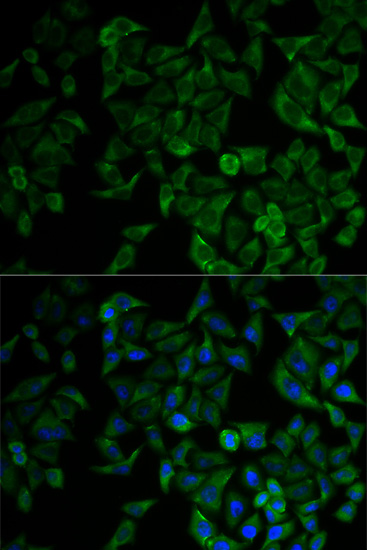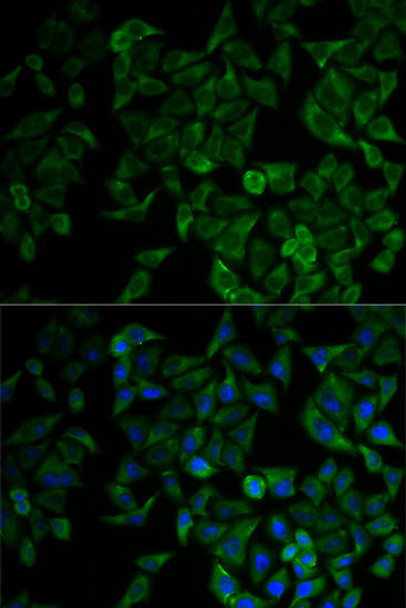Anti-TNFRSF1A Antibody (CAB0033)
- SKU:
- CAB0033
- Product type:
- Antibody
- Reactivity:
- Human
- Host Species:
- Rabbit
- Isotype:
- IgG
- Antibody Type:
- Polyclonal Antibody
- Research Area:
- Cell Death
Description
| 抗体名: | Anti-TNFRSF1A Antibody |
| 抗体コード: | CAB0033 |
| 抗体サイズ: | 20uL, 50uL, 100uL |
| 申し込み: | IF |
| 反応性: | Human |
| 宿主種: | Rabbit |
| 免疫原: | Recombinant fusion protein containing a sequence corresponding to amino acids 241-455 of human TNFRSF1A (NP_001056.1). |
| 申し込み: | IF |
| 推奨希釈: | IF 1:50 - 1:200 |
| 反応性: | Human |
| ポジティブサンプル: |
| 免疫原: | Recombinant fusion protein containing a sequence corresponding to amino acids 241-455 of human TNFRSF1A (NP_001056.1). |
| 精製方法: | Affinity purification |
| ストレージバッファ: | Store at -20'C. Avoid freeze / thaw cycles. Buffer: PBS with 0.02% sodium azide, 50% glycerol, pH7.3. |
| アイソタイプ: | IgG |
| 順序: | SKLY SIVC GKST PEKE GELE GTTT KPLA PNPS FSPT PGFT PTLG FSPV PSST FTSS STYT PGDC PNFA APRR EVAP PYQG ADPI LATA LASD PIPN PLQK WEDS AHKP QSLD TDDP ATLY AVVE NVPP LRWK EFVR RLGL SDHE IDRL ELQN GRCL REAQ YSML ATWR RRTP RREA TLEL LGRV LRDM DLLG CLED IEEA LCGP AALP PAPS LLR |
| 遺伝子ID: | 7132 |
| Uniprot: | P19438 |
| セルラーロケーション: | Cell membrane, Golgi apparatus membrane, Secreted, Secreted, Single-pass type I membrane protein |
| 計算された分子量: | 24kDa/25kDa/38kDa/50kDa |
| 観察された分子量: |
| 同義語: | TNFRSF1A, CD120a, FPF, TBP1, TNF-R, TNF-R-I, TNF-R55, TNFAR, TNFR1, TNFR55, TNFR60, p55, p55-R, p60 |
| バックグラウンド: | This gene encodes a member of the TNF receptor superfamily of proteins. The encoded receptor is found in membrane-bound and soluble forms that interact with membrane-bound and soluble forms, respectively, of its ligand, tumor necrosis factor alpha. Binding of membrane-bound tumor necrosis factor alpha to the membrane-bound receptor induces receptor trimerization and activation, which plays a role in cell survival, apoptosis, and inflammation. Proteolytic processing of the encoded receptor results in release of the soluble form of the receptor, which can interact with free tumor necrosis factor alpha to inhibit inflammation. Mutations in this gene underlie tumor necrosis factor receptor-associated periodic syndrome (TRAPS), characterized by fever, abdominal pain and other features. Mutations in this gene may also be associated with multiple sclerosis in human patients. |
| UniProt Protein Function: | TNF-R1: Receptor for TNFSF2/TNF-alpha and homotrimeric TNFSF1/lymphotoxin-alpha. The adapter molecule FADD recruits caspase-8 to the activated receptor. The resulting death-inducing signaling complex (DISC) performs caspase-8 proteolytic activation which initiates the subsequent cascade of caspases (aspartate- specific cysteine proteases) mediating apoptosis. Contributes to the induction of non-cytocidal TNF effects including anti-viral state and activation of the acid sphingomyelinase. Binding of TNF to the extracellular domain leads to homotrimerization. The aggregated death domains provide a novel molecular interface that interacts specifically with the death domain of TRADD. Various TRADD-interacting proteins such as TRAFS, RIPK1 and possibly FADD, are recruited to the complex by their association with TRADD. This complex activates at least two distinct signaling cascades, apoptosis and NF-kappa-B signaling. Interacts with BAG4, BRE, FEM1B, GRB2, SQSTM1 and TRPC4AP. Interacts with HCV core protein. Interacts with human cytomegalovirus/HHV-5 protein UL138. 3 isoforms of the human protein are produced by alternative splicing. |
| UniProt Protein Details: | Protein type:Receptor, cytokine; Membrane protein, integral Chromosomal Location of Human Ortholog: 12p13.2 Cellular Component: Golgi membrane; extracellular space; cell surface; mitochondrion; integral to plasma membrane; axon; extracellular region; plasma membrane; synapse; nucleus; cytosol; receptor complex; lipid raft Molecular Function:protein binding; tumor necrosis factor receptor activity; protease binding; protein complex binding; tumor necrosis factor binding Biological Process: response to alkaloid; viral reproduction; protein heterooligomerization; response to lipopolysaccharide; tumor necrosis factor-mediated signaling pathway; positive regulation of neuron apoptosis; negative regulation of interleukin-6 production; response to wounding; tetrapyrrole metabolic process; inflammatory response; positive regulation of I-kappaB kinase/NF-kappaB cascade; positive regulation of protein import into nucleus, translocation; cytokine and chemokine mediated signaling pathway; positive regulation of tumor necrosis factor production; response to amino acid stimulus; prostaglandin metabolic process; positive regulation of tyrosine phosphorylation of Stat1 protein; positive regulation of angiogenesis; response to ethanol; induction of apoptosis via death domain receptors; DNA damage response, signal transduction resulting in induction of apoptosis; negative regulation of inflammatory response; defense response to bacterium; response to hypoxia; positive regulation of transcription from RNA polymerase II promoter; positive regulation of inflammatory response; negative regulation of apoptosis Disease: Multiple Sclerosis, Susceptibility To, 5; Periodic Fever, Familial, Autosomal Dominant |
| NCBI Summary: | The protein encoded by this gene is a member of the TNF-receptor superfamily. This protein is one of the major receptors for the tumor necrosis factor-alpha. This receptor can activate NF-kappaB, mediate apoptosis, and function as a regulator of inflammation. Antiapoptotic protein BCL2-associated athanogene 4 (BAG4/SODD) and adaptor proteins TRADD and TRAF2 have been shown to interact with this receptor, and thus play regulatory roles in the signal transduction mediated by the receptor. Germline mutations of the extracellular domains of this receptor were found to be associated with the autosomal dominant periodic fever syndrome. The impaired receptor clearance is thought to be a mechanism of the disease. [provided by RefSeq, Jul 2008] |
| UniProt Code: | P19438 |
| NCBI GenInfo Identifier: | 135959 |
| NCBI Gene ID: | 7132 |
| NCBI Accession: | P19438.1 |
| UniProt Secondary Accession: | P19438,Q9UCA4, A8K4X3, B2RDE4, B3KPQ1, B4DQB7, B4E309 B5M0B5, D3DUR1, |
| UniProt Related Accession: | P19438 |
| Molecular Weight: | 24,194 Da |
| NCBI Full Name: | Tumor necrosis factor receptor superfamily member 1A |
| NCBI Synonym Full Names: | tumor necrosis factor receptor superfamily, member 1A |
| NCBI Official Symbol: | TNFRSF1A |
| NCBI Official Synonym Symbols: | FPF; MS5; p55; p60; TBP1; TNF-R; TNFAR; TNFR1; p55-R; CD120a; TNFR55; TNFR60; TNF-R-I; TNF-R55; TNFR1-d2 |
| NCBI Protein Information: | tumor necrosis factor receptor superfamily member 1A; TNF-R1; TNF-RI; TNFR-I; tumor necrosis factor-alpha receptor; tumor necrosis factor receptor type 1; tumor necrosis factor binding protein 1; tumor necrosis factor receptor 1A isoform beta |
| UniProt Protein Name: | Tumor necrosis factor receptor superfamily member 1A |
| UniProt Synonym Protein Names: | Tumor necrosis factor receptor 1; TNF-R1; Tumor necrosis factor receptor type I; TNF-RI; TNFR-I; p55; p60; CD_antigen: CD120aCleaved into the following 2 chains:Tumor necrosis factor receptor superfamily member 1A, membrane form; Tumor necrosis factor-binding protein 1; TBPI |
| UniProt Gene Name: | TNFRSF1A |
| UniProt Entry Name: | TNR1A_HUMAN |
 | Immunofluorescence analysis of HeLa cells using TNFRSF1A antibody (CAB0033). Blue: DAPI for nuclear staining. |

